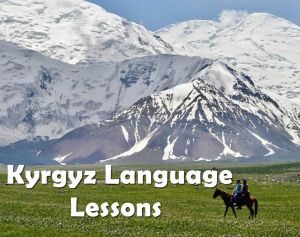Language/Kirghiz/Vocabulary/Introducing-Yourself
| ◀️ Basic Greetings — Previous Lesson | Next Lesson — Subject-Object-Verb Order ▶️ |
As a Kirghiz language teacher with more than 20 years of experience, I am excited to welcome you to this lesson on introducing yourself in Kirghiz. This is an essential topic to master if you want to communicate effectively with native speakers and create lasting connections.
In this lesson, you will learn how to properly introduce yourself and ask for someone's name in Kirghiz. You will also learn how to address people politely and show respect for their cultural norms. So, let's get started!
With the completion of this lesson, consider investigating these related pages: How to say Good Bye? & How to Say Hello and Greetings.
Basic Greetings
Before we dive into introducing yourself, let's review some basic Kirghiz greetings. It's always important to start any conversation with a polite greeting, and there are a variety of ways to say hello in Kirghiz.
- Salam - Hello (informal)
- Kandaisynyz? - How are you? (informal)
- As-salamu alaykum - Peace be upon you (formal)
- Kandaisiniz? - How are you? (formal)
- Jalghyzby - Hello (respectful)
Practice saying these greetings out loud to help you remember them better.
Introducing Yourself
Now that you know some basic Kirghiz greetings, let's move on to introducing yourself. When meeting someone for the first time, it's common to share your name and a little bit about yourself. Here's how to do it in Kirghiz:
- Menin atym (name) - My name is (name)
- Men (age) jashymdayin - I am (age) years old
- Men (job/title) emesim - I am not a (job/title)
For example:
| Kirghiz | Pronunciation | English |
|---|---|---|
| Менин атым Жанболот | Menin atym Janbolot | My name is Janbolot |
| Мен 25 жашындаймын | Men 25 jashymdayin | I am 25 years old |
| Мен кыргызча окуучу эмесмин | Men kirgizcha okuuçu emesmin | I am not a Kirghiz language student |
Remember to also inquire about the other person's name and ask how they are doing:
- Sizdin atynyz kim? - What is your name? (formal)
- Kandaisiniz? - How are you? (formal)
Here's how you can reply:
- Menim atym __________. Kandaisynyz? - My name is __________. How are you?
Addressing People Politely
In Kirghiz culture, it's important to show respect for others by addressing them appropriately. Here are some common ways to address people based on their age and relationship to you:
- Äne - Mother
- Baba - Father
- Aka - Older brother (if you are male)
- Ana - Older sister (if you are male)
- Adesh - Younger brother (if you have the same father)
- Ata - Grandfather
- Eni - Grandmother
To show respect to someone you are meeting for the first time, it's best to use formal address:
- Siz - You (formal)
Use informal address with people you know well or who are the same age as you:
- Sen - You (informal)
Practice Conversation
Now that you have learned some basic vocabulary and grammar rules, let's practice a conversation to introduce yourself and ask for someone's name:
A: As-salamu alaykum! B: Wa alaykumu as-salam! Kandaisiniz? A: Rahmat, sïz kandaisiniz? B: Rahmat, sïzdin atynyz kim? A: Menim atym Zamira. Sïzdin atynyz kim? B: Menin atym Beknazar. A: Siz janaanayz? B: Janaanam. Siz kayrajan bolsoto?
Translation: A: Peace be upon you! B: And peace be upon you too! How are you? A: I am fine, how about you? B: I am fine too. What is your name? A: My name is Zamira. What is your name? B: My name is Beknazar. A: Are you doing well? B: Yes, I am. How about you?
Conclusion
Great job on completing this lesson on introducing yourself in Kirghiz! With this knowledge, you will be able to confidently initiate conversations with natives and create lasting connections. Remember to practice speaking out loud to improve your pronunciation and speed. Stay tuned for our next lesson on the basics of sentence structure.
Excellent job on conquering this lesson! Consider delving into these related pages: Clothes & Fruits.
Other Lessons
- Time
- Sports and Games
- Count to 10
- Basic Greetings
- House
- Express Surprise
- Ordinal Numbers
- Family
- Transport
- Family Members
Sources
- Learn the 30 most important words in Kirghiz!
- Learn Kirghiz with the unique long-term memory method (2023)
| ◀️ Basic Greetings — Previous Lesson | Next Lesson — Subject-Object-Verb Order ▶️ |

